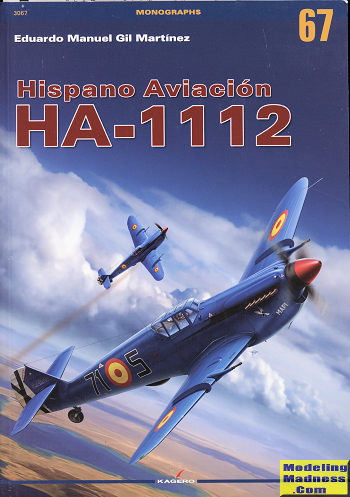 The Ha.1112
was the culmination of the Bf-109 story that began in the mid 1930s and did not
end until over 35 years later. It was born of a need and an inability to really
do much anything other than what was at hand.
The Ha.1112
was the culmination of the Bf-109 story that began in the mid 1930s and did not
end until over 35 years later. It was born of a need and an inability to really
do much anything other than what was at hand. |
Author: |
Eduardo Manuel Gil Martinez |
|
Publisher |
Kagero |
|
Price |
$27.95 from Casemate Publishing |
|
Reviewer: |
|
| Notes: | #3067. ISBN 978-83-66148-33-8, 80 pages |
 The Ha.1112
was the culmination of the Bf-109 story that began in the mid 1930s and did not
end until over 35 years later. It was born of a need and an inability to really
do much anything other than what was at hand.
The Ha.1112
was the culmination of the Bf-109 story that began in the mid 1930s and did not
end until over 35 years later. It was born of a need and an inability to really
do much anything other than what was at hand.
In the mid 1940s, prior to the end of the war, the Spanish government was allowed to license build the Bf-109G-2. Thing went slowly during this process and while several complete airframes were supplied along with the plans for the tooling, what was a bit slow in coming were engines. The DB.605 was in great demand at home and eventually, few actually made it to Spain.
When the war was over, Spain was pretty much a pariah state, due to its leader and that fact it was still a fascist nation. No one would sell them military equipment; even stuff left over from the war. Some DB.605 engines were obtained somewhat clandestinely, but they proved to be unusable. The only choice was to use locally manufactured Hispano-Suiza engines. Several airframes were converted and small scale production was undertaken, but these planes really were not what was needed and had constant issues with the engines.
To make a long story short, in 1953 the embargo was lifted and Spain was able to make a deal for several hundred Merlin engines. These were used to power Mosquitos and were really what was needed. They were reliable, fairly easy to maintain and get parts and they worked well in the G-2 airframes that had been built and stored.
These aircraft really did not enter service until the late 1950s as things moved very slowly in Spain. They were used as ground attack aircraft in the Ifni war in the Spanish Sahara, but were not well suited for it. However, when one has air superiority, even obsolete aircraft can be effective and these, along with armed T-6s were. Eventually they were pulled from service in the mid 1960s shortly after the last ones were delivered.
After being removed from service they were stored in anticipation of scrapping. However, the movie industry saved the last two dozen or so as they became stars in the movie 'Battle of Britain', which was released in the late 60s. After this, they have seen a few more movie appearances, but most were sold off to museums, warbird enthusiasts and collectors. Some have been re-engined with DB-605 engines and while they look like genuine Bf-109s, they are the Spanish Hispanos.
The author had done a great job researching the development and deployment of the aircraft. I found the development to be particularly interesting, especially considering all the obstacles that had to be overcome to put what was essentially an obsolete aircraft into service. I also found its war history in Spanish Sahara of interest as I'd just finished reading about this conflict in another book. Many will also like reading about its movie career as they modified the planes with clipped wing tips and fake stab braces to look like E model 109s.
There are a lot of photos and some great full color profiles to go along with it. Now I have to mention this was not easy to read. There seems to have been no English editor for this and the author's English is a bit strained with a lot of sentences with odd syntax that at times require multiple readings. There is also a lot of repetition of information, sometimes several times. Same goes with the photos. There are color photos in the book that are repeated in black and white in other places in the book. Almost as if the author or editor was trying to meet a minimum page count. Looking past that, it is a very nice book that provides the most complete history of the type that I have yet read. If you are a real fan of the 'Buchon', then you may well want to consider this one.
October 2019
Copyright ModelingMadness.com. All rights reserved.
My thanks to Casemate Publishing for the review copy. You can get yours at this link.
If you would like your product reviewed fairly and fairly quickly, please contact me or see other details in the Note to Contributors.